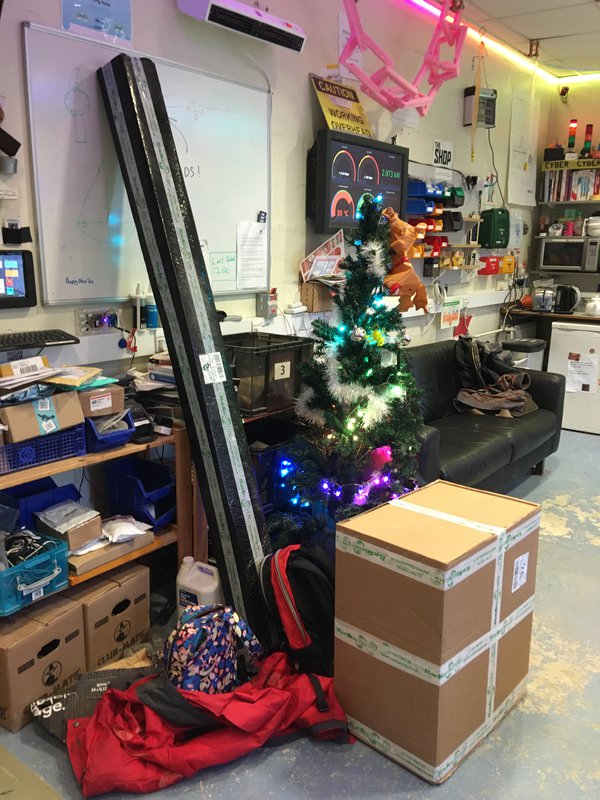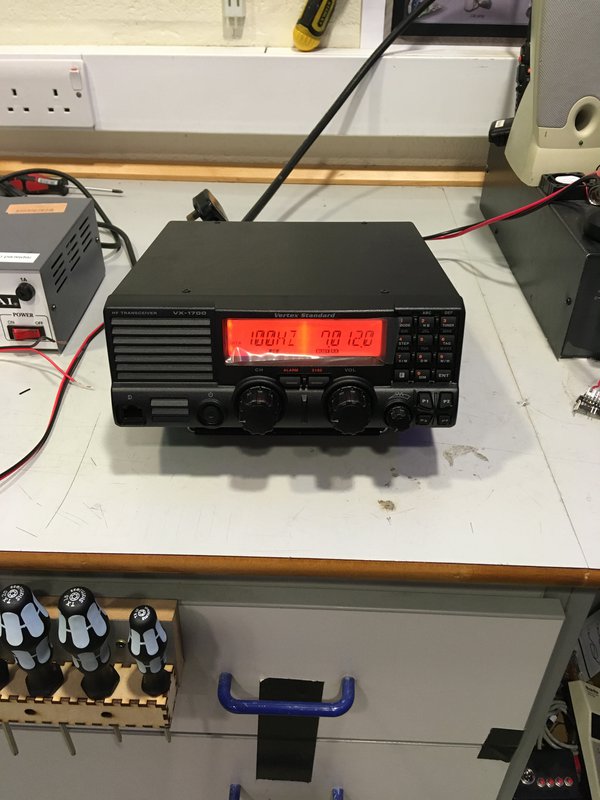Vertex Standard VX-1700
Today some surplus radio equipment arrived at the lab that will be part of the amateur radio station aboard Hale Kai.
 In the box is a Vertex Standard VX-1700. These radios are sold mainly as land mobile transceivers to be installed in government and NGO vehicles, similar to the Codan radios that we used when I worked with the UN. They support fancy features like automatic link establishment (ALE) and encryption, but at their core, they are simply robust HF transceivers. Vertex Standard is the same company that makes Yaesu radios: Yaesu is their amateur radio division.
In the box is a Vertex Standard VX-1700. These radios are sold mainly as land mobile transceivers to be installed in government and NGO vehicles, similar to the Codan radios that we used when I worked with the UN. They support fancy features like automatic link establishment (ALE) and encryption, but at their core, they are simply robust HF transceivers. Vertex Standard is the same company that makes Yaesu radios: Yaesu is their amateur radio division.
 Together with the radio came an antenna coupler, an SG-230 made by SGC suitable for matching the radio to a long-wire antenna (e.g. a backstay antenna). It also came with a conspicuous whip antenna designed to be mounted on a Humvee or Land Cruiser or some such. I don’t have one of those so it may not be of much use.
Together with the radio came an antenna coupler, an SG-230 made by SGC suitable for matching the radio to a long-wire antenna (e.g. a backstay antenna). It also came with a conspicuous whip antenna designed to be mounted on a Humvee or Land Cruiser or some such. I don’t have one of those so it may not be of much use.
The VX-1700 is normally set up to be used by people trained to use radios, not by engineers or radioamateurs. This means that it’s normally set up with a bunch of standard channels, much like a marine radio, and it isn’t permitted to choose frequencies and modes directly. When set up this way, the radio is much less flexible. There are a number of ways to enable variable frequency oscillator (VFO) mode to get around this. One is by shorting two pins on the data connector on the back of the radio. Another is by simply enabling VFO mode using some difficult to obtain “CE-77” software that needs an obsolete version of Windows.
Alfie MM0AAL and I found a third way. Actually, the radio arrived in something called “dealer mode” which seems to have all of these features enabled. But we discovered how to program the radio, including setting “dealer mode”, without needing to run dodgy software.
What happened was this. After making up a power cable, the first thing that we did with the radio was, obviously, hook it to a computer to see if digital transmissions would be possible. In doing this, somehow, the radio became locked. It had a little padlock displaying on the screen and nothing that we could do would unlock it again. It is possible to program one of the four “soft-keys” on the front to lock and unlock it, but they didn’t work, and we didn’t have the dodgy software that would do this.
After some experimentation, we found some undocumented button combinations. When the radio is powered on while holding certain buttons, things happen:
- F + ENT: displays RL CLEANING and the relays click a bunch.
- F + 1 or F + 4: all symbols on the display illuminate. This is probably a diagnostic for checking the display for faults.
- F + 0: asks for a password.
The last one was definitely intriguing. We found that, pressing F would provide access to a limited number of settings. Pressing ENT would start entering a four digit passphrase. The default passphrase, or at least the one on this radio, found after a bit of trial and error, is 0123. Press ENT again and apparently the full range of settings is available. No need for special software at all.
The fix, of course, four the problem of the locked radio was to go through the settings and assign the LOCK feature to one of the soft-keys (I chose P2). It is also very useful to put transmit power selection on another of the soft-keys as the radio arrived only able to transmit at 100W and no lower. This can damage some antenna couplersthat want not more than 10W during tuning as well as radios that would otherwise have to deal with large amounts of reflected power during tuning.